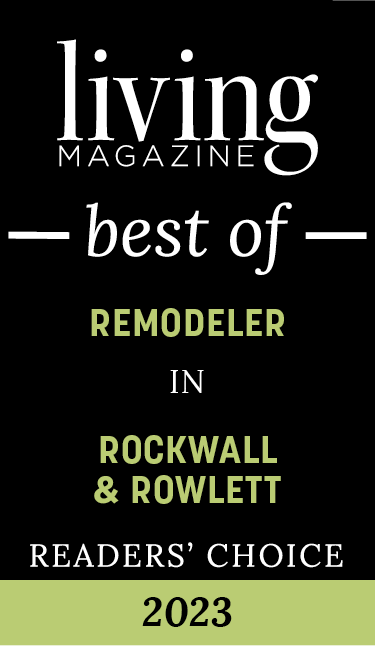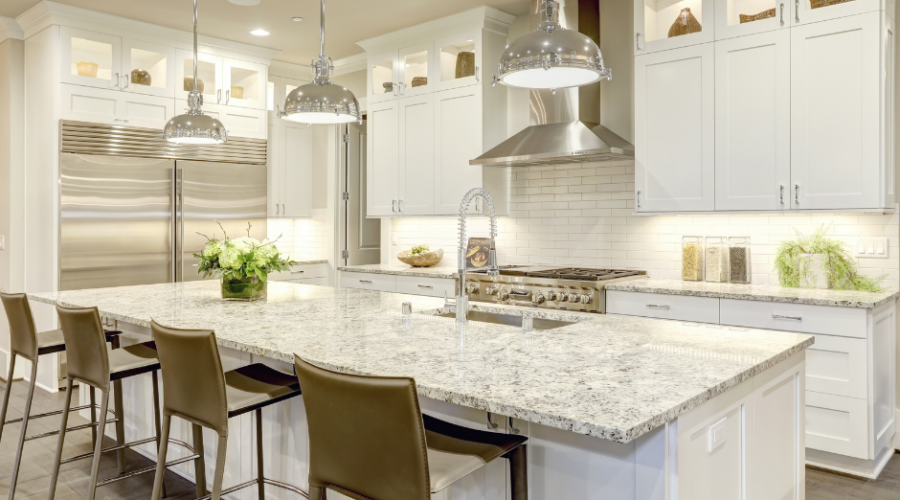
The kitchen is the heart of every home, and having a functional layout is crucial for its effectiveness. A well-designed kitchen layout ensures everything is in its proper place, making cooking more comfortable, safer, and enjoyable. Whether renovating an existing kitchen or designing a new one from scratch, here are some essential steps to help you create a functional kitchen layout.
Determine the Kitchen’s Primary Use
Before deciding on a kitchen layout, consider the primary use of the kitchen. Is it for cooking, entertaining, or both? This knowledge will help your DreamMaker Kitchen Designer guide your decision-making process.
If your kitchen is primarily for cooking, a functional layout will include ample counter space, storage for pots and pans, and easy access to appliances like the stove, oven, and refrigerator. A U-shaped or L-shaped kitchen layout is ideal, as it maximizes available space and provides a seamless workflow.
If your kitchen is for entertaining guests, the primary focus should be creating a welcoming atmosphere. The kitchen should be open and spacious, allowing guests to mingle freely. The layout should also include a designated area for serving food and drinks. An island or a peninsula is an excellent addition to this type of kitchen as it provides additional counter space and serves as a gathering spot for guests.
Measure the Space
it’s essential to take accurate measurements of your kitchen space. Measuring the area will help you determine the right size and type of appliances and cabinets that will fit perfectly in your kitchen. It will also help you avoid buying oversized or undersized items that may not fit your kitchen layout.
When measuring your kitchen space, your Kitchen Designer will start by taking the length and width of each wall. Then, measure the distance between the floor and the ceiling. Additionally, measure the size of any existing appliances, such as a refrigerator, oven, or dishwasher.
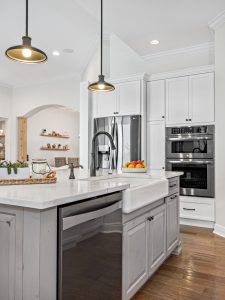 Once our Designer has all the measurements, we can create a rough sketch or use software to design your kitchen layout. Together we can experiment with different layouts and configurations to find the one that suits your needs and preferences.
Once our Designer has all the measurements, we can create a rough sketch or use software to design your kitchen layout. Together we can experiment with different layouts and configurations to find the one that suits your needs and preferences.
A well-designed kitchen layout will make your kitchen look beautiful and help you work efficiently and reduce the risk of accidents. Our DreamMaker Kitchen Designer will help you every step of the way.
Determine the Work Triangle
The work triangle is the path between the refrigerator, stove, and sink. The ideal work triangle is between 12 and 26 feet. This distance ensures enough space to move around the kitchen without feeling cramped.
The goal of the work triangle is to make the flow of the kitchen as efficient as possible. When designing your kitchen, consider placing these three elements in a triangular formation, with each side of the triangle between 4 and 9 feet long. This allows for ease of movement and accessibility to all three elements.
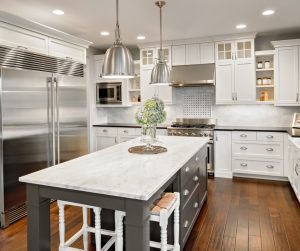
However, it’s important to remember that the work triangle is just a guideline, not a strict rule. Other factors, such as the size and shape of your kitchen and the placement of windows and doors, should also be considered.
Another critical element in creating a functional kitchen layout is to ensure that you have enough counter space. Ideally, you should have at least 36 inches of counter space on either side of the stove and sink. This allows for ample space for food preparation and cooking.
In addition, consider the placement of your cabinets and drawers. Place frequently used items, such as cooking utensils and spices, in easily accessible areas. This will save you time and effort when cooking.
Choose the Kitchen Layout
Several kitchen layouts include U-shaped, L-shaped, galley, and island. Choose a layout that suits your needs and preferences.
One popular layout option is the U-shaped kitchen. This layout is ideal for larger kitchens and provides ample counter and storage space. With three walls of cabinetry and appliances, the U-shape allows easy access to everything you need while cooking. It also provides plenty of room for multiple people to work in the kitchen simultaneously.
Another familiar layout is the L-shaped kitchen. This design is perfect for smaller kitchens and provides a more open feel. By placing appliances and cabinets along two walls, this layout allows for plenty of counter space while still maintaining an efficient workflow. It’s also an excellent option for those who like to entertain, as the open design allows for easy interaction between the cook and guests.
The galley kitchen may be the way to go if you prefer a more streamlined look. This layout features two parallel walls of cabinets and appliances, creating a narrow but efficient workspace. It’s a popular choice for those who live in apartments or smaller homes, as it maximizes every inch of available space.
The kitchen island has become a popular addition to many kitchen layouts. Islands provide additional counter space and storage and a place for guests to gather while the cook works their magic. Islands can be incorporated into any of the above layouts, making them a versatile option for any kitchen.
Plan for Storage
Adequate storage is essential in a functional kitchen. Plan for enough cabinets, drawers, and shelves to store your kitchen items. Consider adding a pantry or a kitchen island with storage.
Consider your kitchen’s layout and available space. If you have a small kitchen, your Designer may need to get creative with storage solutions like open shelving or hanging pots and pans. If you have a larger kitchen, you may have more cabinet and pantry space flexibility.
Next, think about the items you will store in your kitchen. Consider the size and shape of your dishes, pots, pans, and any appliances you plan to keep. Plan for enough space to store all your kitchen essentials.
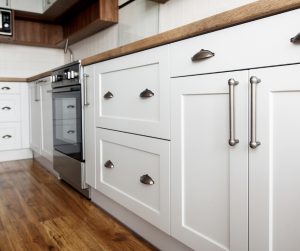
When it comes to cabinets, consider installing pull-out shelves or drawers to make accessing items in the back more manageable. Utilize vertical space by installing cabinets up to the ceiling or adding floating shelves.
For pantry storage, consider installing a combination of shelves and drawers to store items of varying sizes. Labeling shelves and drawers can also make it easier to find what you need quickly.
Don’t forget about countertop storage. Consider installing a utensil holder, knife block, or even a built-in cutting board to keep your most-used items within arm’s reach.
Consider Lighting
When designing a kitchen layout, lighting is often an overlooked factor. However, a well-lit kitchen can make a massive difference in functionality and ambiance.
First, it’s essential to consider the different types of lighting needed in a kitchen:
- Ambient lighting provides general illumination and can come from ceiling fixtures or recessed lighting.
- Task lighting is more focused and often used for cooking and food preparation.
- Accent lighting highlights specific features or areas in the kitchen, such as a backsplash or a piece of artwork.
To create a functional kitchen layout, it’s crucial to incorporate all three types of lighting. Start by placing ambient lighting fixtures in the center of the room and add task lighting in areas where you’ll do most of your cooking and prep work. This could include under-cabinet lighting or pendant lights above the kitchen island. Finally, consider adding accent lighting to showcase decorative features or add a warm glow to the room.
Another vital factor to consider when designing your kitchen lighting is the color temperature of your bulbs. Warm white bulbs (around 2700K) create a cozy, inviting atmosphere, while cool white bulbs (around 4000K) are ideal for task lighting and providing a bright, energizing environment.
Lighting is a crucial aspect of creating a functional kitchen layout. By incorporating different types of lighting and choosing the right color temperature, you can create a warm, inviting, practical, and aesthetically pleasing space.
Creating a functional kitchen layout can seem overwhelming, but you can achieve your dream kitchen with careful planning and attention to detail. With these steps, you’re on your way to a functional and beautiful kitchen that you’ll enjoy for years.
A functional kitchen layout should be tailored to your needs and lifestyle. Planning your space carefully will ensure that your kitchen works as hard as you do.
To explore the exciting possibilities of a new kitchen design and layout, contact the kitchen experts at DreamMaker Bath & Kitchen of Rockwall, TX.

Happy cooking!













